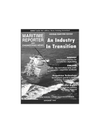
Page 52: of Maritime Reporter Magazine (September 1996)
Read this page in Pdf, Flash or Html5 edition of September 1996 Maritime Reporter Magazine
—_ ^r j i - gag s HA 0T • • • : • li
NQ fM&iii -v.. • • - -TSUI- : »» « gsiKa
Fi
Finland's maritime industry continues to push the envelope of innovation, offering a plethora of advanced vessels, products and systems to the world.
The Finnish maritime industry is perhaps best characterized by the specialty vessels, products and services its companies provide.
The country's maritime industry is invariably tied closely to the passenger vessel market, and
Finnish companies design, build and equip some of the most technically advanced and lux- urious cruise ships and ferries in the world.
The equipment supply and subcontractor infra- structure is well developed, and is a major fac- tor in helping to keep the country at the fore- front of passenger vessel development. The fol- lowing offers a synopsis of significant activities during the past year.
More Than Cruise ships
While the passenger vessel segment is of obvi- ous importance, it does not fully represent the capabilities of the overall industry.
Finnish yards and suppliers are well-regard- ed for partaking in the most advanced commer- cial projects. The main shipyard players are
Kvaerner Masa-Yards (KMY) New Helsinki
Shipyard and Turku New Shipyard, as well as
Finnyards. These companies have established themselves as building experts of niche, techni- cally advanced ships.
An example of this is Mubaraz (pictured above), which was the first of a four LNG carri- er, $1 billion+ order for the Kvaerner Masa-
Yards' New Turku Shipyard. Mubaraz and its sistership, Mraweh., embody a host of propri- etary Finnish technologies. Aside from that,
Mubaraz has the distinction of being the largest ship ever built in Finland.
The second of the four LNG carriers for Abu
Dhabi National Oil Co. (newbuilding No. 1331) was delivered in early June. The 135,000-cu.- m. carrier Mraweh is one of the largest LNG carriers in the world. The LNG cargo contain- ment system is based on the Kvaerner Moss- type spherical aluminum tank concept, and these LNG carriers are the first 135,000-cu.-m. capacity carriers with only four spherical cargo tanks. The tank manufacturing method was developed at the Turku New Shipyard.
The LNG vessel gets its propulsion power from its own cargo, as boil-off gas is burned in steam boilers.
Much design work for the series was focused on ship operation costs, including improved fuel economy, seakeeping performance and maneu- verability. The ship's slender hull form is of a new low resistance type, and early operation reports from Mubaraz and Mraweh have proven these goals have been met.
The Turku yard has offers a series of different sized LNG carriers (from 45,000 to 180,000-cu.- m.) to meet diversified customer demands.
Passenger Ship Expertise
Finnyards, meanwhile, has been busy finish- ing the new series of HSS (high speed service) vessels for Stena. Stena Explorer — the first of three HSS 1500 craft, 415.4 x 131.2-ft. (126.6 x 40-m) sisterships from Finnyards in Rauma — is powered by a gas turbine system designed and supplied by Norway's Kvaerner Energy, and utilizes a General Electric (GE) aeroderiv- ative gas turbine. The HSS can reportedly carry 1,500 passengers and 375 cars, and is designed to operate at 40 knots in seas of 16.4 ft. (5 m), due to its gas turbine propulsion sys- tem. The vessel is widely considered a quan- tum leap into the future of ferry travel. Its 52 Maritime Reporter/Engineering News

 51
51

 53
53
